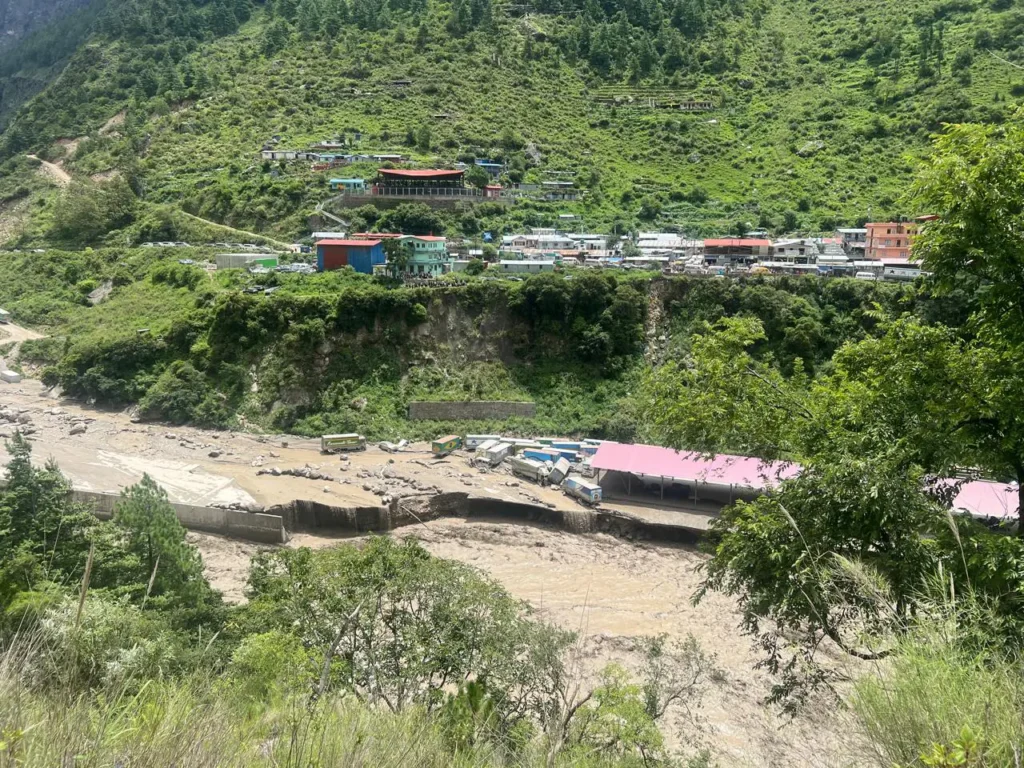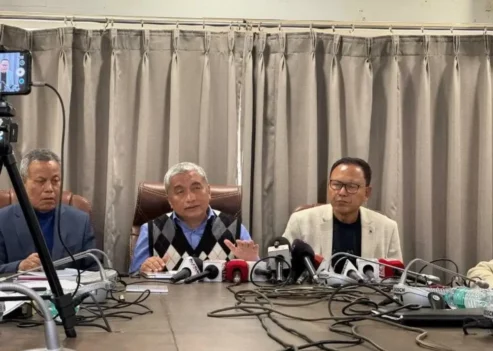Kathmandu, July 23: A destructive glacial lake outburst flood (GLOF) from the Tibet Autonomous Region of China struck the northern front district of Rasuwa in Nepal in the early hours of July 8, killing at least nine people, with another 19 or 20 still missing. Caused by the rapid breaching of a supraglacial lake in Tibet that had developed due to the rapid thawing of ice and snow, the devastating flood swept away the Nepal-China Miteri (friendship) Bridge and damaged one kilometer of highway, thus breaking a crucial road connection and trade with China. The flood also damaged hydropower projects, leading to a combined output loss of some 200 MW, and swept away or buried over 100 cargo containers and electric vehicles parked at the local dry port and customs yard.
The flood, which hit the area despite minimal local rainfall, once again has spotlighted the threat that Nepal is susceptible to due to its exposure to climate disasters.
The ‘epicenter’ of the flood—the supraglacial lake formed in the middle of a glacier—was located about 35 kilometers above Rasuwa in Tibet. After a large lake had formed due to melting snow, the glacier released the water as a flood, according to officials of the National Disaster Risk Reduction and Management Authority (NDRRMA) of Nepal. “The glacial flood traveled through the Lhendekhola, Bhote Koshi, and Trishuli rivers, spreading into Nepal, wreaking havoc,” says NDRRMA chief, Engineer Dinesh Prasad Bhatta.
This inundation, as with many others that came before it, is of an ominous pattern. As temperatures in the world rise, the Himalayan cryosphere of Nepal is undergoing radical transformations. Previously stable ice and snow at higher elevations is, at an unprecedented rate, thawing away. Supraglacial lakes—temporary, unstable lakes that appear on glaciers as they thaw—are being observed increasingly, and their chances of bursting are rising perilously, as the Rasuwa tragedy showed.
A flood that recently hit Lomanthang in Mustang is also suspected to have been caused by a burst or leaking glacial lake. Similarly, on May 15, floods occurred in Humla district after two glacial lakes burst in the upper Himalayan region above Tilgaon.
In previous years too, floods from high-altitude Himalayan regions have swept into villages in Nepal. On August 16, 2024, a GLOF resulting from the bursting of two glacial lakes in Solukhumbu devastated the Thame village. Similarly, in 2021, a glacial lake above the Melamchi area burst and caused a huge flood.
However, the most recent Rasuwa flood is slightly different as it is trans-boundary in nature.
Satellite images paint a disturbing picture
According to scientists and researchers, the flood in Rasuwa was caused by the leakage of water from a supraglacial lake—covered with soil and snow—into the glacier. Dr. Basanta Raj Adhikari, Director of the Center for Disaster Studies at the Institute of Engineering, Tribhuvan University, explains that supraglacial lakes, which form in the Himalayan region due to temperature fluctuations, are dynamic and temporary in nature.
Satellite images show that many of the lakes now seen in Tibet did not exist before 2021. According to ICIMOD scientists, small lakes captured in 2022 satellite imagery had expanded into larger lakes by 2023. The same lake that had completely disappeared by mid-December 2024 reappeared again around July 4–5.
Glaciologists say that several days before the Rasuwa flood, a large amount of snow had melted in the upper part of the glacier. Satellite image analysis shows that snow visible on July 5 had completely melted by July 7. The melted snow and ice chunks had accumulated in a large pool formed on the glacier, and the ground surrounding the pool was too weak to hold it. As a result, the pool burst, releasing the floodwaters into Nepal the next day.
With rising temperatures during the summer months, the pace of snowmelt increases. Combined with seasonal rainfall, this greatly increases the risk of glacial lake outbursts across the Himalayan regions.
Dr. Adhikari of the Center for Disaster Studies emphasizes that rising temperatures due to climate change are accelerating the melting of snow in Nepal, “although all such events in Nepal cannot be linked to climate change due to the lack of data.”
ICIMOD’s 2023 assessment, titled ‘Water, Ice, Society, and Ecosystem in the Hindu Kush Himalayas’, stated that the glaciers, snow and permafrost of the Hindu Kush Himalayas are “undergoing unprecedented and largely irreversible changes over human timescales, primarily driven by climate change” and “are some of the most vulnerable to these changes in the world.”
According to NDRRMA Chief Bhatta, there are 47 large high-risk glacial lakes in Nepal’s international border areas—25 in Tibet, 21 in Nepal, and one in India. So, 26 of these lakes pose increasing risks due to transboundary water flows. Reporting an increasing trend of glacial lakes bursting or leaking in Nepal, ICIMOD has recommended continuous monitoring and research. However, no detailed study has been conducted on glacial lakes in Nepal since 2015.
Climate change: Nepal’s unwarranted crisis
“The formation of glacial lakes in the high-altitude glaciers takes place due to the melting of snow and ice because of the rise in temperatures, which in turn is because of climate change. Therefore, it’s now clear that the July 8 Rasuwa flood was a climate change-triggered disaster,” notes Arun Bhakta Shrestha, a senior climate change specialist associated with ICIMOD. “It is sad to note that Nepal, despite contributing very, very little to global emissions, is suffering disproportionately from the devastating impacts of climate change. This is Nepal’s unwarranted crisis.”
Greenhouse gas emissions in Nepal total very little, less than 0.05% of global emissions, yet the country is most at risk from climate change. Due to its unique topography—steep mountains, large valleys, and fragile geology—its climate shocks render it very vulnerable. Nepal is home to over 3,000 glaciers and over 2,000 glacier lakes that cover the entire expanse of the Himalayas, and it is most at risk from climate change catastrophes such as GLOFs, flash floods, landslides, and erratic monsoons.
Himalayan research centers have been citing the threat that the HKH region is warming at twice the global average rate. An ICIMOD report published in 2020 unveiled the fact that at least 21 glacier lakes of Nepal are set to burst right away. Though the ominous threat has emerged, there has been no new research study for nearly a decade.
Economic and human cost
The Rasuwa loss is greater than an environmental issue—it has renewed closure of essential trans-boundary trade and faith travel. The Rasuwagadhi-Kerung crossing, which accounted for over 70% of the Nepal–China trade, was effectively closed after the Miteri Bridge destruction, both symbolically and traditionally, and large sections of the roads on the Nepal side have been made impassable.
Since the suspension, Nepali officials have initiated emergency consultations on diverting trade via the Sindhupalchok-based entry point of Tatopani, but the latter has sometimes been closed during monsoon-month closures caused by landslides. Traders now anticipate higher transport costs and bottlenecks, and most of them have the option of using the remote and expensive Kolkata route.
While the religious tour operators—on whom the Rasuwagadhi route has traditionally depended to bring Indian and Nepali pilgrims to Tibet’s Mount Kailash—are in a state of panic, with hundreds of pilgrims having been stranded and the Rasuwagadhi route still long from being resumed, alternatives are being considered, such as the Tatopani route or the higher-fee Hilsa air route via Humla.
A glacial wakeup call
The recent Rasuwa flood bears an unpleasant fact: the Himalayas are fast transforming, and Nepal lies squarely in the danger zone. The supraglacial lakes being created throughout the Tibetan plateaus—most of which did not appear until 2021—are new, active, and highly unstable. Scientists explain that temperature variations of several degrees or more in higher-elevation sites produce radical snow and ice behaviour discrepancies, frequently with deadly results downstream.
“The Rasuwa flood should serve as a wakeup call for us,” says Dr. Adhikari.
While Nepal raises the cause of climate justice to the world’s agenda, its voice is muted among the larger voices of the developed world. This is one of the vast injustices of the climate tragedy: the least guilty pay the maximum price.
What Must Be Done
Nepal faces the urgent need to update the glacial lake risk assessments. For this purpose, the government must resume and institutionalize the systematic monitoring of the glacial lakes, most of which overlap with areas close to the international border and significant infrastructures.
The country also needs to invest in early warning systems. Real-time monitoring and alert systems are hard to install in the mountains, but will still save materials and lives. Similarly, Nepal has to take the mainstreaming climate adaptation route. By that, infrastructure, bridge, and road design must be climate-resilient at all levels.
It is also important that Nepal achieves transboundary coordination with China since the majority of the glacier sources of probable future disasters are in China. Accordingly, Nepal must step up diplomatic coordination towards the exchange of information in real time, early warning, and common mitigation preparation.
“Nepal doesn’t have its own satellite. So we need data from China’s satellites. It’s high time Nepal’s political leadership took initiatives with their Chinese counterparts for that,” observes Bhatta.
Similarly, the country has to raise its voice louder in climate diplomacy. As the Himalayan areas get warmer, the country has to vigorously promote global climate aid and technology transfer, and that is true, most importantly, for mountain-centric vulnerabilities.
The Rasuwa flood is extraordinary, but it is the symbol of a general and fast-unraveling climate breakdown within the Himalayas. It has existential implications for Nepal. One country that has contributed so little to the world’s heating is situated directly in the middle of its most extreme impacts. The world must wake, take notice, and act before glacier surges rewrite the future of Nepal.







